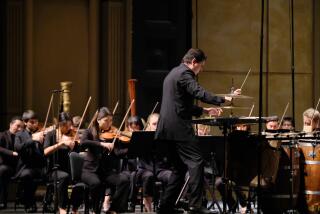The Boston Pops Formula for Success
- Share via
BOSTON — Conceived 106 years ago as a summer job for the Boston Symphony Orchestra, the Boston Pops today is a multimillion-dollar operation with an international reputation, eagerly sought after by impresarios and recording company executives.
Thanks to its touring, recordings, TV and radio broadcasts, it has huge name recognition, and those elements of success have been carefully watched by executives of the new Hollywood Bowl Orchestra, several of whom have had ties with the Pops.
But the $25-million BSO/Pops organization differs from the L.A. Philharmonic Assn.-sponsored Hollywood Bowl Orchestra in two key areas:
* The players: Each year the Boston Symphony, minus most of the principal players, metamorphoses into the Boston Pops. Under the direction of John Williams, the Boston Pops plays six concerts a week for seven or eight weeks. Occasionally, Pops players are substituted with performers from the Boston Esplanade Orchestra, another offshoot from the BSO organization. Like the Hollywood Bowl Orchestra, the full-size Esplanade Orchestra is composed of free-lancers who play only six concerts a year. Its big event is the annual Fourth of July festivities on the Charles River.
Fenwick Smith, BSO acting principal flute player, explains why he and his colleagues are happy to play in the Boston Pops: “We have the option of taking off the entire season, which is eight weeks, or taking one or two weeks off. About 15 of our members may take those few weeks off but there are very few who take the entire season off--a handful.”
Smith says this is partly because the Pops season is so lucrative. “We did eight TV shows and recorded three CDs this year. We get the same salary 52 weeks a year, but with TV and recording we get paid extra on top of that.”
* The revenues: Although BSO managing director Kenneth Haas says the Pops runs a deficit--just as the symphony does--the fact is that on a concert-by-concert basis the Pops does better than the symphony. Pops brings in almost $5 million in ticket sales compared with $7 million for the symphony gate, according to the latest available figures. But the Pops also brings in the lion’s share of a reported $2.5 million in TV, radio and recording fees, making its total revenues close to $7 million, all with 54 fewer concerts than the BSO.
While the BSO has practically no televised performances, for 22 years the Pops has been broadcast on 286 PBS stations. “Evening at Pops” series remains welcome entertainment across the United States.
As for recordings, there are more Pops albums still in the market than BSO recordings. In the ‘80s, for example, Philips recorded 20 Pops albums. Now it is mixing them and repackaging the old ones for resale. Even some of the old Arthur Fiedler albums still sell well enough to have space on the record shelves. Industry analysts estimate that Pops outsell the BSO recordings 5-to-1.
As for the view of this new entry on the Pops scene, Haas sees the Bowl Orchestra as a plus. “I want to emphasize that we are not in competition with the Hollywood Bowl Orchestra,” Haas says. “They only broaden the audience, which is good for us too.”
More to Read
The biggest entertainment stories
Get our big stories about Hollywood, film, television, music, arts, culture and more right in your inbox as soon as they publish.
You may occasionally receive promotional content from the Los Angeles Times.










